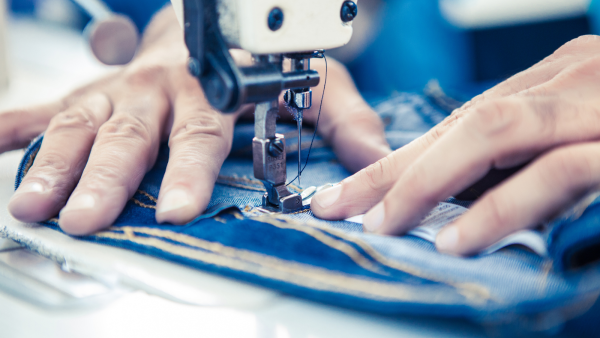Changing the Shape of the Textile Industry
June 17, 2022
When it comes to clothes, the switch from a linear to circular life cycle is crucial to the future of our planet.
Marketing for the fashion and textile industries often encourages constant consumerism. Social and print media ads urge us to “buy now, pay later!” or “treat yourself, you deserve it!” Our wallets are suffering the consequences of fast fashion, but so is our planet.
This March, the annual UNC Clean Tech Summit took place at the Friday Center in Chapel Hill. The two-day event features industry professionals, keynote speakers, and panelists to educate attendees on how we can transition to a low-carbon economy.
With fashion and textiles contributing immensely to our global carbon footprint, new technology and out-of-the-box thinking are solving the industry’s biggest problems. While at the summit, I had the chance to hear from two panelists who are improving the current life cycle of textiles, Peter Majeranowski and Bob Carswell.
Majeranowski, CEO and co-founder of Circ, is a former U.S. Naval Officer whose passion for environmentalism stems from his time serving abroad. Carswell is now Research and Development Director at the Material Return after over a decade in the furniture industry. Both companies are at the forefront of advanced technology, weaving technical science and creativity into solutions for the sustainable reuse of textiles.
In 2018, U.S. households sent 11.3 million tons of textiles to the landfill. The sustainability issues related to the life cycle of textiles are a growing concern for both businesses and consumers, with textile waste and production emitting greenhouse gases, leaching dyes and toxins into surrounding environments, and producing vast amounts of wastewater. But increasing awareness of these problems is giving way to a market for solutions.
Fashion’s Environmental Costs
Cotton, nylon and polyester, which comprise the trifecta of modern-day textiles, are depleting resources that are already scarce, and doing so at an alarming rate.
“Resource intensitivity and wastefulness are two of the largest factors when it comes to the environmental cost of the textile and fashion industries,” said Majeranowski.
For textiles, resource insensitivity relates to water, energy, fossil fuels and arable land, all of which are at risk of depletion.
Growing cotton requires large plots of land, degrades soil quality, uses pesticides, and needs a lot of water. Polyester is produced from crude oil through an energy-intensive and chemical-heavy process. Similarly, nylon is both water-intensive and energy-intensive, not biodegradable, and production processes emit greenhouse gases more potent than CO2.
“The environmental degradation starts way before what anyone would even recognize as a t-shirt,” said Majeranowski.
And this inability to recognize degradation is a big problem.
The current lack of corporate transparency is a crucial missing link. The power customers have over the choices made by big brands is instrumental in transitioning to more sustainable business practices.
“There is a gap in consumer knowledge. Industry transparency on supply chains and worker equality needs to be more upfront in product description. We all need to work together to make this industry more sustainable and educate people,” Carswell told me.
But, every aspect of the textile industry is beginning to shift towards transparency and sustainability. From raw materials to production to disposal, companies like Circ and the Material Return are emerging to tackle issues associated with each phase of a textile’s life.
Solution Spotlight: Circ and the Material Return
“Linear systems are just not sustainable from a supply, environmental, and cost point of view,” said Majeranowski.
The goal for the journey from unfinished textiles to wearable clothing is a concept called circularity. Improving upon the traditional linear model, one that begins with resource inputs and ends with landfills, Circ and the Material Return are swapping recycling and reuse into the process.
“The technology utilizes a process called thermal hydrolysis. The poly-cotton textiles undergo heat and pressure that breaks down polyester molecules into their base ingredients and essentially un-sticks them from the cotton,” Majeranowski explained.
“What results is a liquid mixture of the base ingredients from the polyester that can be re-constructed, and the raw cotton, which can also be reused.”
At scale, this technology has the ability to uproot the entire industry for the better.
Similarly, Carswell and his team at the Material Return are repurposing textile waste into new yarns that are then spun for textile production.
“We are a mechanical recycler that breaks textile waste back down to the original fiber form. We work with synthetic and natural blends that fit our clients’ performance needs to close the loop on their process and product with the recycled yarns and fabrics produced in our network.”
But the fight doesn’t end here. Both Majeranowski and Carswell say their companies are continually working towards minimizing their waste, improving their processes, and reducing their carbon footprints.
What About Production?
While the end-of-life phase of textiles is one of the industry’s biggest challenges, the problem begins with production.
It’s now common to see clothing made from used plastic bottles, abandoned fishing nets, and even kelp.
I consulted Dr. Hans Paerl, a marine ecologist who studies harmful nutrient levels in our aquatic systems, to discuss my skepticism about greenwashing.
Hans thinks kelp textiles are a good idea overall. One reason is that it is biodegradable.
“For example, if it ends up in a landfill, it will degrade. From a whole systems perspective, kelp takes up nutrients from its environment.”
Thus, nutrient overloading in our aquatic systems can actually benefit from harvesting kelp while reducing the estimated 450 years it takes for a plastic bottle to decompose to almost nothing. At the same time, ocean animals and coral reefs are spared from the impacts of ghost fishing nets.
“I think these are the solutions. To have a bunch of different source materials like algae, hemp, flax. If we go all-in on one thing, that’s when you start depleting.”
About the Author
This article was written by Ryan Morris, a UNC senior and environmental studies major.
